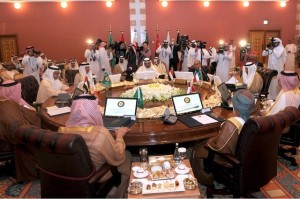by William D. Hartung
With the end of the Obama presidency just around the corner, discussions of his administration’s foreign policy legacy are already well under way. But one central element of that policy has received little attention: the Obama administration’s dramatic acceleration of U.S. weapons exports.
The numbers are astonishing. In President Obama’s first five years in office, new agreements under the Pentagon’s Foreign Military Sales (FMS) program—the largest channel for U.S. arms exports—totaled over $169 billion. After adjusting for inflation, the volume of major deals concluded by the Obama administration in its first five years exceeds the amount approved by the Bush administration in its full eight years in office by nearly $30 billion. That also means that the Obama administration has approved more arms sales than any U.S. administration since World War II.
The majority of the Obama administration’s arms sales—over 60 percent–have gone to the Middle East and Persian Gulf, with Saudi Arabia topping the list at $46 billion in new agreements. This is particularly troubling given the complex array of conflicts raging throughout the region.
The Saudi intervention in Yemen is just the latest example of the potentially disastrous consequences of runaway U.S. arms exports. The Obama administration has set new records for the value of U.S. weapons deals with the Saudi regime. The Saudis have used U.S.-supplied weaponry to help put down the democracy movement in Bahrain, and now to expand the conflict in Yemen to the point that it may spark a region-wide war. In addition, over $500 million in U.S weaponry destined for Yemeni security forces has gone missing, and may have found its way to Houthi forces or even to al-Qaeda in the Arabian Peninsula. The faction of the Yemeni army that has joined hands with the Houthi rebellion has ample U.S.-supplied armaments as well. It’s hard to imagine a clearer example of the negative consequences of aggressive arms dealing than the current situation in Yemen.
To be fair, the Bush administration has done more than its fair share in proliferating weaponry to current and potential U.S. adversaries in the Middle East. A significant portion of the $25 billion in arms and training supplied to Iraqi security forces—most of it on Bush’s watch—was abandoned to Islamic State (ISIS or IS) forces when they swept through northern Iraq in summer 2014, and IS also captured weapons that the CIA supplied to “moderate” Syrian factions. The Obama administration’s $500 million plan to arm and train forces to fight IS in Syria may not fare much better.
Although U.S. arms are contributing to violence and chaos in the Middle East, some of the largest payoffs for U.S. weapons-exporting firms have come far from any current battlefield. Lockheed Martin’s F-35 combat aircraft program—the largest weapons initiative ever undertaken by the Pentagon—depends in part on billions in sales to a dozen foreign partner nations, ranging from NATO members like the United Kingdom, Italy, and Turkey to non-NATO allies like Australia, South Korea, and Israel. Although many of these connections were established during the Bush years, the Obama administration has worked assiduously to expand exports of the F-35.
Team Obama has also been working overtime to open new growth markets like exports to India. The United States has made nearly $5 billion in arms sales to India in the past five years, most notably for Boeing C-17 transport planes but also including torpedoes, anti-ship missiles, and howitzers. And a new U.S.-India defense cooperation agreement that Obama announced during his January 2015 visit to India includes promises to help India develop aircraft carriers and a new generation of jet engines.
Controlling Arms Sales?
One area of arms transfer policy where the Obama administration has had a positive impact is in its support for a global Arms Trade Treaty (ATT). Unlike the Bush administration, which was joined at the hip with the National Rifle Association—a determined opponent of the ATT—the Obama administration supported the treaty, albeit not in as strong a version as some arms control advocates would have liked. Although the treaty has no hope of being ratified by the current, Republican-controlled Senate, the Obama administration has signed it and publicly pledged to live up to the standards on human rights, anti-corruption, and other key criteria set out in the ATT. The key question now is what this commitment will mean in practice.
Unfortunately, even as the Obama administration has committed itself to monitoring and controlling arms exports under the ATT, it has loosened internal U.S. requirements on the licensing of weapons and weapons-related exports. The most important element of the administration’s multifaceted arms-export reform initiative was the decision to remove thousands of items from the State Department-monitored U.S. Munitions List (USML) and place them on the Commerce Control List administered by the Commerce Department. The Commerce Department has historically been more closely associated with arms-export promotion than arms-export control, and its regulations are considerably looser than the State Department’s.
This Obama administration’s policy shift could inadvertently make it easier for U.S. weapons to fall into the hands of terrorists or human rights abusers. The most likely channel for such illicit transfers would be via front companies set up in countries that can now receive significant military equipment and arms components without a license. The absence of a strict licensing requirement will make it harder to keep track of the ultimate destination of military and military-related items exported by U.S. companies.
The second major problem with the Obama administration’s deregulation of arms exports is that weapons and weapons components that are moved to the jurisdiction of the Commerce Department are not likely to receive the regular human-rights vetting that occurs during the State Department’s licensing process.
The Obama administration has defended its new arms export control policy as an effort to put “higher fences around fewer items” so that scarce enforcement resources can be concentrated on high-end weapons and weapons components whose transfer could undermine U.S. military superiority. But the administration’s narrow focus on controlling the flow of modern equipment to potential competitors or major adversaries ignores the danger posed by making it easier to export low-tech items that can be used by repressive regimes, such as guns, light vehicles, and surveillance equipment. On balance, the Obama administration’s arms export licensing reforms are a step backwards.
New Policy on Drones
The most controversial arms-export policy question of all may be determining what countries are allowed to purchase armed or arms-capable drones from the United States. The Bush administration never enunciated a clear policy on this issue, but after years of deliberations the Obama administration announced its approach earlier this year.
On first glance the details of the new Obama drone export policy seem relatively unobjectionable. It calls for the approval of drone exports “on a case-by-case basis.” It also requires recipients to pledge not to use U.S.-supplied systems to illegally attack neighboring states or engage in “unlawful surveillance” or “unlawful force” against their own populations. And the administration has pledged to engage in rigorous end-use monitoring to ensure that these systems are only used for agreed-upon purposes and are not transferred to third parties without U.S. approval.
Unfortunately, the reasonable standards enunciated by the Obama administration aren’t likely to prevent the misuse of U.S.-supplied drones in practice. Once the United States supplies weaponry to a nation or group, it has very little control over how that weaponry is used. U.S. arms supplied to anti-Soviet fighters in Afghanistan ended up in the hands of violent jihadis, some of whom ended up as founding members of al-Qaeda. And, as indicated above, Middle Eastern allies from Bahrain to Egypt to Saudi Arabia have used U.S-supplied weapons to put down democracy movements. Yet Washington may be tempted to supply drones to precisely these regimes for use in the war on IS. Indeed, in late February it was revealed that the next recipient of U.S. drones might be the United Arab Emirates, which is slated to get an unarmed version of the General Atomics Predator system. Under the new Obama policy, will the sale of armed drones to the Persian Gulf be far behind?
The ongoing expansion of U.S. arms exports has potentially devastating consequences for human rights, regional stability, and U.S. security. It’s time for Congress and the public to hold the Obama administration to higher standards in this critical area of foreign policy. Otherwise, the spectacle of U.S. weapons being used to fuel conflict, enable human rights abuses, and foster instability in key areas of the world is likely to continue unabated.
William D. Hartung is the director of the Arms and Security Project at the Center for International Policy and a senior advisor to the Security Assistance Monitor.






Nothing like being the war monger in chief, especially with the plethora of goods available for export. Super power, Super Market Inc. Combining all the ingredients mentioned in the post, the slogan: “It’s our way or the highway”, sure takes on a new meaning.
Is Obama to blame for these record sales? Any sitting US president has limited powers and is handcuffed by so many legislative checks and balances. Meanwhile the machinery of government grinds on, chewing up anyone that gets in the way.
Oh well, as long bloodshed is being shed in far off lands US public opinion will be cool with that. They will look the other way when the US deliberately fans the flames of hatred and violence in these places which = arms sales + profits.
Maybe its time for the US to have civil war. Last time it was fought over slavery. Maybe this time they have one between those states that support gay rights and those that don’t.
“The majority of the Obama administration’s arms sales—over 60 percent–have gone to the Middle East and Persian Gulf, with Saudi Arabia topping the list at $46 billion in new agreements. ”
This is exactly why the supposed current detente with Iran is a charade. There’s no profit in peace like there is in war.
“War is a racket. . .the only one in which the profits are reckoned in dollars and the losses in lives.” — MajGen Smedley D. Butler, USMC, double recipient of the Congressional Medal of Honor, 1935
I wonder if it’s possible to parse out how much the current expansion of U.S. arms exports is attributable to domestic concerns. I’m thinking here of the economy — boosting weapons sales was one way to keep the ship afloat in a recession.